How To Install A Door Into A Frame
Tips for Hanging Doors
These seven pro tips volition help you hang doors faster and amend.
Introduction
A veteran carpenter shares his secrets about how to hang a door plumb and truthful fifty-fifty if the rough opening isn't perfect. Even a novice can master his techniques with a trivial practise.
Tools Required
Materials Required
- 3-in. screws
- Wood shims
Project step-by-step (7)
Stride 1
Shim before the door goes in
Shim the easy way

Marker the location of the hinges on the drywall alongside the opening then yous'll know where to identify the door shims. Place door shims at the top and bottom hinge locations using a long level or a direct board and a short level. And so add the center door shims.
Yous already know the standard approach to hanging a door: Set information technology in the rough opening, then level, shim and nail information technology. This traditional approach works fine in a perfect world where walls are always plumb, floors are level and you accept plenty of fourth dimension to fuss with the fit. Just in the real world, some nonstandard tricks can assist you finish the chore faster and amend.
The usual method of holding the door frame in place while you shim backside the hinge side is awkward. Information technology's a lot easier to shim the hinge side of the crude opening earlier you put in the door frame. Subsequently that, information technology's a simple job to set the interior door frame in place, screw or nail it to the shims, and so shim the strike side. Measure the width of the rough opening before yous kickoff shimming to see how much shim infinite is available. Commonly the rough opening allows for nigh one/2 in. of shimming on each side of the frame. If the rough opening is extra wide, you can use fewer shims by tacking scraps of 1/2-in. plywood at the hinge locations first, and then add shims to plumb the jamb.
What is a Pocket Door?
Step 2
Make sure an exterior door clears the rug
Avoid clearance problems

Screw a strip of plywood to the bottom of the crude opening to raise the door and prevent it from rubbing on the floor inside.
Most of the time, you lot tin can simply set your new exterior door frame directly on the subfloor and the door will easily articulate carpeting or a throw rug. But if y'all're replacing an old door with a thick sill, or if the floor will be built upwardly with tile, thick carpet or an extra layer of forest, yous could have a problem. And there'south no easy solution after the door is installed. You can't only trim the lesser, because then the door won't seal against the sill. To avoid this problem, add a spacer under the door before you install information technology. The key is to make up one's mind where the top of the tile, rug or throw rug volition be, and then enhance the door frame to leave about a 1/ii-in. infinite under the door (photo).
How to End Door Drafts Around Entry Doors
Footstep 3
Set up interior jambs on spacers
Avoid trimming door bottoms
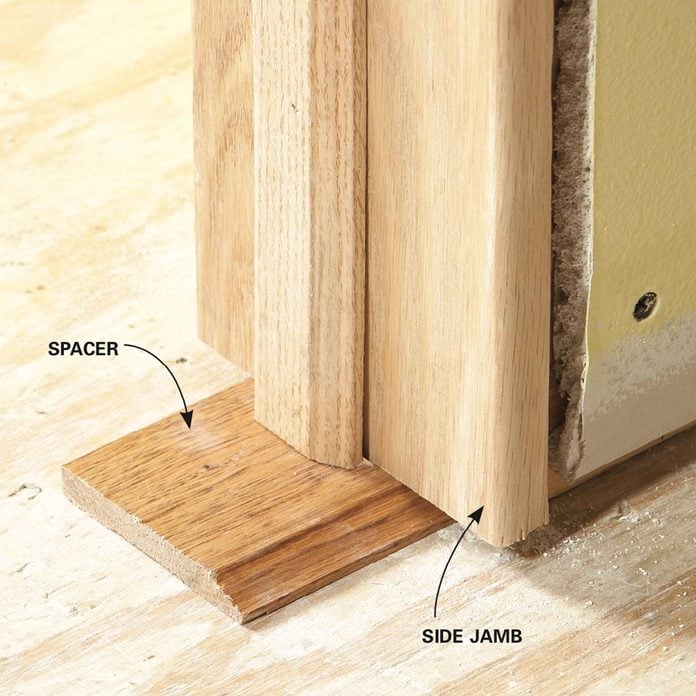
Enhance interior door jambs with scraps of trim to make sure the door volition clear the carpeting. If you gear up the interior door jambs directly on the subfloor, there's a skillful chance the door will rub against the carpet after. Of course, you can cutting off the lesser of the doors, but it'southward piece of cake to avoid this extra work by planning alee. Find out the thickness of the finish floor and then summate where the bottom of the door will be. Program the installation and then in that location will be virtually 1/2 to 3/4 in. of space under the door. Usually setting the doorjambs on scraps of 3/8- to 1/2-in.-thick trim will put the door at the correct acme.
How to Make a DIY Rustic Barn Door and Hardware
Footstep 4
Hidden screws brand outside doors stronger
Hide the screws
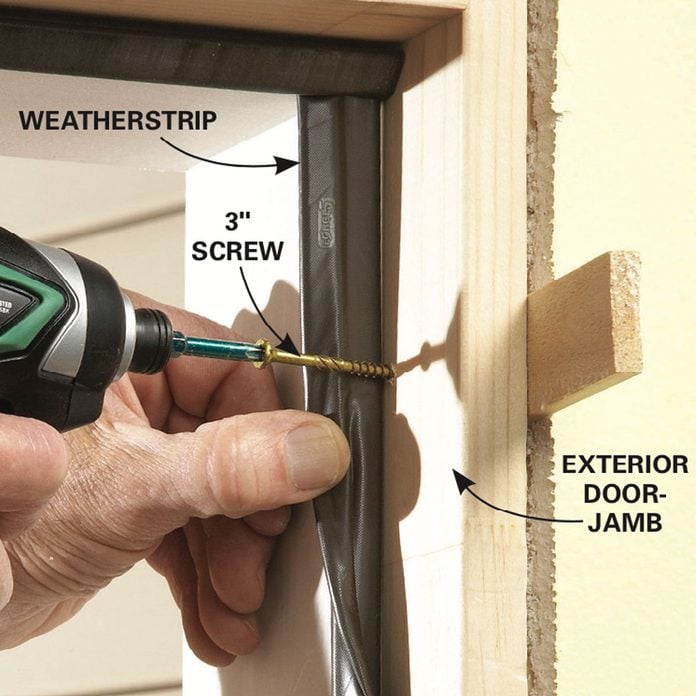
Pull back or remove the weather strip on the latch side of the door frame and bulldoze screws where they'll be hidden. There are many benefits to using screws rather than nails to install exterior doors. They can be adjusted and won't easily pull out or loosen. Just yous don't want to leave the painter with the task of filling large, ugly screw holes. The trick is to hide the screws under the weather stripping on the latch side. On the hinge side, you lot tin can but replace one screw in each hinge with a matching three-in.-long screw. Always offset by drilling a clearance hole that allows the screw to slide freely in and out of the hole. This ensures the screw volition pull the jamb tight to the shims, and allows for adjustment if needed. Don't let the spinning screw rub confronting the weather strip—it will slice correct through. I know this from bitter feel.
Great Tips for Painting Doors
Pace 5
Tune upwards the crude opening
How to build a door frame correct: Check for plumb
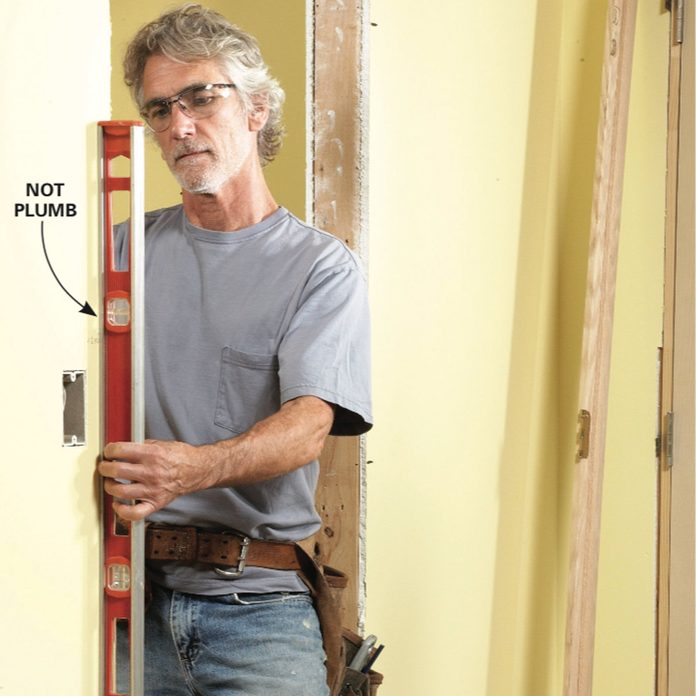
Check both sides of the door opening. If they're more than 1/4 in. out of plumb, adjust them before you install the door.
Nudge the wall
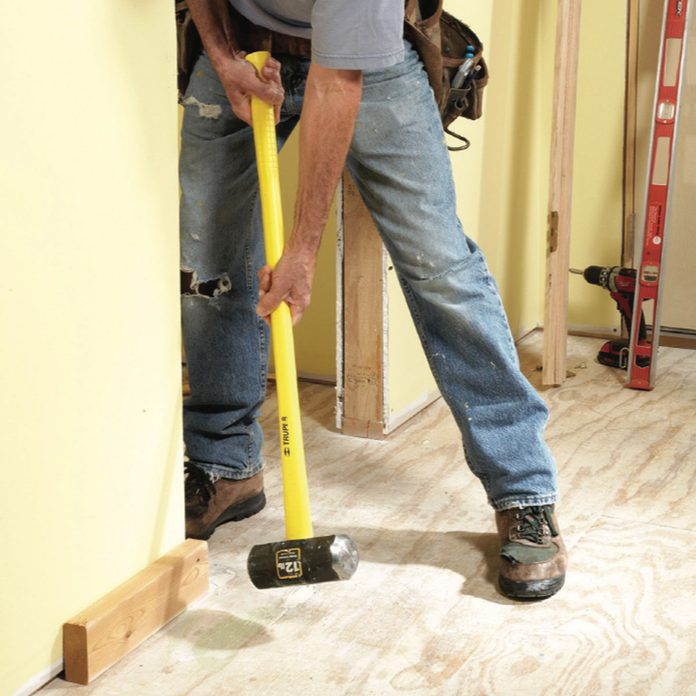
Protect the wall with a 2x4 bit while you motility the lesser of the wall over with a sledgehammer. When the wall is plumb, toe-screw the lesser plate to the floor to hold it in identify.
Twisted or out-of-plumb rough openings raise havoc with door installations. If you install the jambs to follow the walls, the door is likely to swing open or close on its ain. On the other hand, if you lot plumb the jambs against the out-of- plumb crude opening, the trim volition be hard to install.
As long as the bottom of the wall isn't held in place by floor, in that location's a simple solution. Only movement the studs on both sides of the opening back to plumb. Don't remember you can do this with your trim hammer, though. You'll need a maul or a sledgehammer.
How One Pro Installs a Door in Four Like shooting fish in a barrel Steps
John Schumacher, possessor of Millwork Specialties Ltd. in Minnesota, has been installing doors and millwork for more than 20 years. He's learned to avoid callbacks by doing the job right the first time. Hither's his door installation method in a nutshell.
1. Plumb the swivel jamb
The swivel side of the door has to be plumb or the door will swing open or closed on its own. Beginning past shimming the hinge side of the crude opening. First make marks to point the centers of the hinges. And so apply a long level or a long, straight board along with a short level to plumb the shims. Tack a pair of tapered shims at the superlative swivel. Then install the bottom shims and finally make full in the middle.
ii. Screw the swivel-side jamb to the stud
Remove the door from the frame and fix information technology aside. Remove the hinge leaves from the jamb. Set the door frame in the opening with the jamb resting on the finished floor (Photograph 2) or on a spacer. Drive iii-in. screws through the jamb where they'll be subconscious past the screws.
3. Arrange the gap forth the top
Slide shims between the floor and the latch-side jamb until the caput jamb is level. Now reinstall the door hinges and the door. Adjust the door shims nether the latch-side jamb until the gap betwixt the top of the door and the top jamb is even.
4. Shim and blast the latch-side jamb
Shim behind the latch-side jamb to make an even gap betwixt the door and the jamb. Usually three or four sets of door shims, evenly spaced forth the jamb, are plenty. Drive two finish nails into each prepare of shims to concord the jamb in place. Cutting off the protruding door shims with a fine-tooth saw or a utility knife.
How to Remove a Door
Step 6
Trim the bottom to level the top
Bank check with a level
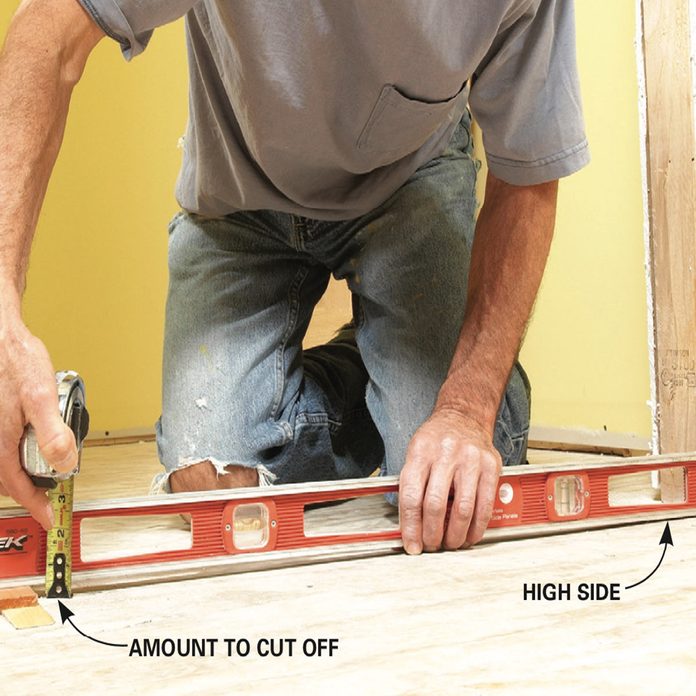
Level across the opening and shim upward 1 side until the chimera is centered. The distance between the level and the floor tells you how much to cut off the jamb.
Cutting the high-side jamb
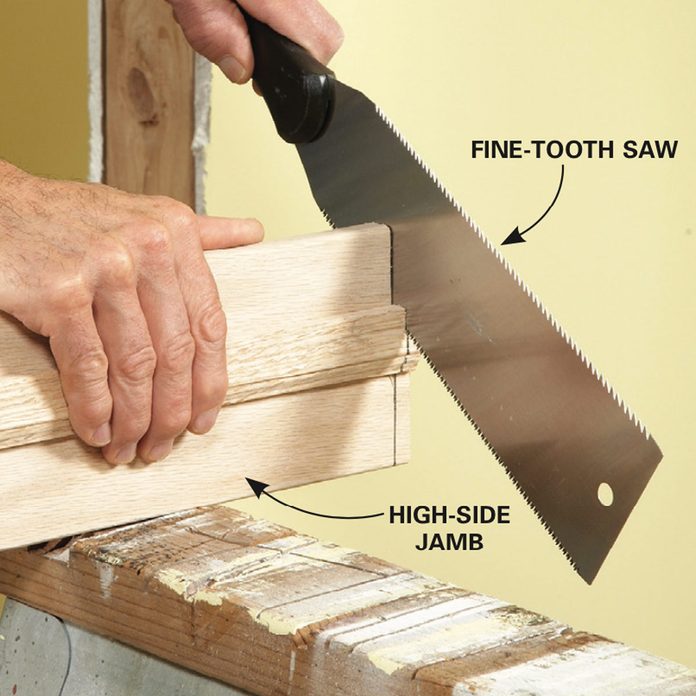
Trim the jamb with a fine-molar saw. A "Japanese"-way pull saw cuts fast and leaves a clean cut. Old houses are notorious for having sloping floors. Even some newer houses settle in unexpected ways. If y'all don't cut the interior door jamb to compensate for the out-of-level flooring, you could have a problem getting an even space between the top of the door and the head jamb. This is disquisitional if y'all're installing a door over existing floor where the jambs have to fit tightly to the floor. Photos ane and 2 show how to trim the jambs to fit a sloping floor.
How to Replace an Exterior Door
Step 7
When installing door hinges: Hide screws behind the hinges
Use screws, not nails
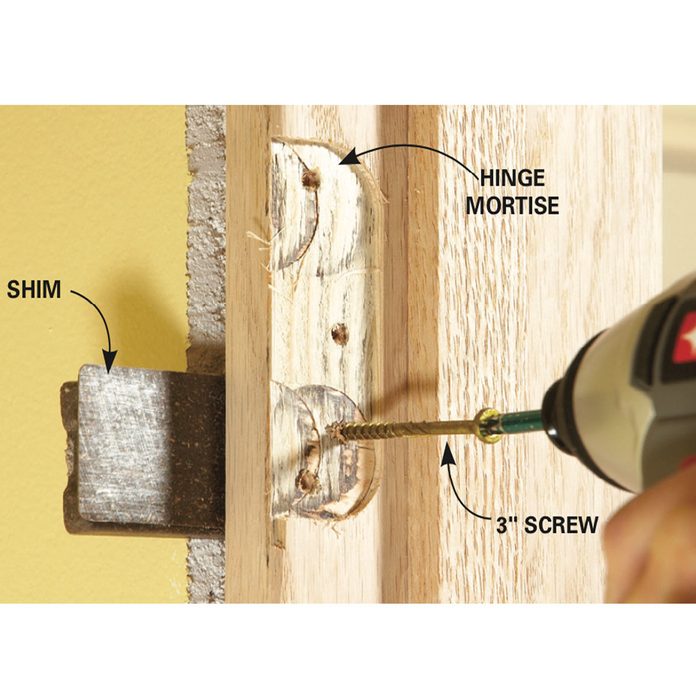
Screw through the jamb in the hinge mortise. The screws volition concur improve than nails and will be hidden by the hinges. Screws are better for securing the hinge jamb considering nails can work loose. You can hands replace one of the curt hinge screws with a long screw, but it can be difficult to find a strong screw that matches the other screws. Here'south a trick we learned. Hibernate the screw behind the hinge. It only takes a minute or 2 to remove all the hinges and gain admission to this area. And so y'all tin drive a self-drilling spiral through the jamb with ease. Make sure the jamb is straight and plumb before you reinstall the hinges.
Trouble-Shooting Tips
Door Won't Latch
Out-of-plumb jambs or a warped door can crusade this. If the door won't latch because it's hitting the latch-side stop on the top or bottom, the fix is to move the stop. If it only needs a fiddling adjustment, you can just tap information technology over with a hammer and a block of wood. Otherwise, pry information technology off carefully, and with the door closed and latched, reinstall information technology confronting the door.
Door Binds and Resists Closing
If the door isn't rubbing against the jamb, but at that place'due south tension when yous endeavor to close it, and so it's bounden on the swivel jamb. Commonly this means you lot haven't shimmed correctly and the jamb isn't at a right angle to the wall. Fix this problem by adjusting the swivel-side door shims to twist the jamb back to a right angle with the wall.
All Most Smart Door Locks: Keyless Entry, Bluetooth, and More
Originally Published: May xx, 2022
Source: https://www.familyhandyman.com/project/tips-for-hanging-doors/
Posted by: williamsontooll1944.blogspot.com


0 Response to "How To Install A Door Into A Frame"
Post a Comment